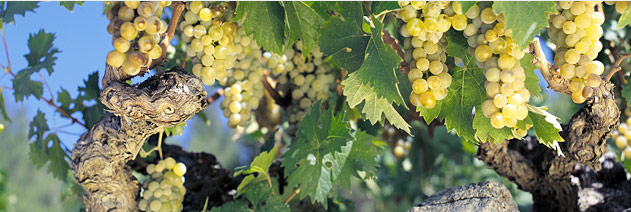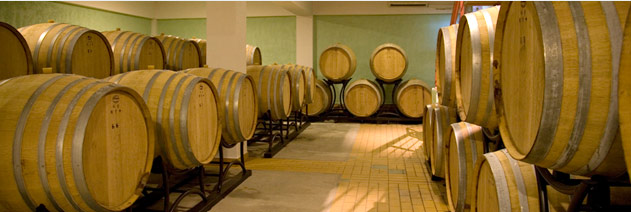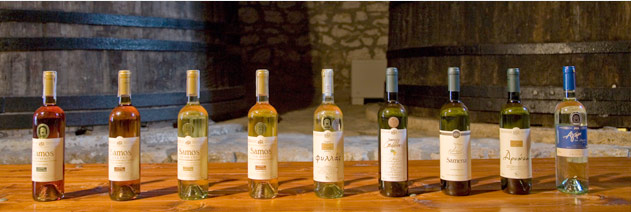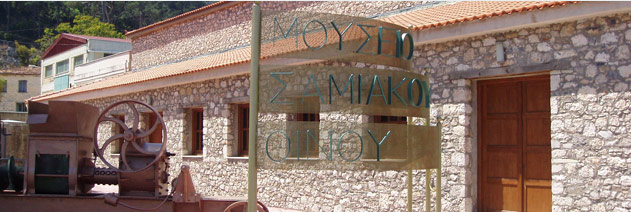Samos Wines

UNION OF VINICULTURAL COOPERATIVES OF SAMOS
The Union of Vinicultural Cooperatives of Samos (EOSS) was founded in 1934 with the participation of 26 local cooperatives representing all of the wine growers on the island.
From the outset, EOSS was in a position to undertake the substantive task of protecting the rights of wine growers in their dealings with wine merchants, since it functions as a trade union.
Since its foundation, EOSS has been harvesting grapes and crafting wine in two wineries located in the areas of Malagari and Karlovassi, respectively. From the wineries, the union distributes its bulk or bottled wine to the rest of Greece and throughout the world.
Exports constitute a significant part of EOSS business activities and cover 80% of the approximately 7,000 tons of wine the Union produces annually. France alone imports 60% of the wine produced on the island of Samos, while other countries that also import large quantities of Samos wines are England, Australia, Austria, Belgium, France, Germany, Denmark, Switzerland, the USA, Italy, Canada, the Netherlands, Singapore, Sweden, Finland, Scandinavian countries in general and, quite recently, Far East countries.
THE VARIETY

In Samos, the white muscat grape reigns king. Also known as the Muscat blanc à petits grains or Muscat de Frontignan, in Greece it sometimes goes by the name of moschoudi.
This is a noble variety fairly popular around the Mediterranean basin and widely planted in other parts of Greece as well. However, only in Samos does it produce the fat, luscious wines for which the island is known.
The muscat grape covers about 97% of Samos’ vineyards, with the remaining 3% shared by ritino and fokiano - red grape varietals used for the production of rosé wines - and some rarer table grape varieties (including the astonishing kolokythato).
THE WINERIES

The Union maintains two complete wineries, each one with its own rich tradition.
The Karlovassi winery serves the vineyards of the villages situated on the northern part of the island, while the Malagari winery, nestled a short distance from the town of Vathi, serves the rest of the island, while at the same time housing the Union's central offices.
Visitors to the Malagari facilities may also enjoy a stroll around the Samos Wine Museum which opened its doors to the public in 2005 in one of the oldest parts of the winery. Both EOSS wineries are open to the public during business days and hours.
PRODUCTS

The muscat wine “SAMOS”, with a guaranteed appelation of origin, is produced from the grapes bearing the same name, the famous Samos Muscat Blanc à Petits Grains, cultivated on the slopes of Mount Ambelos, on the traditional island tiered terraces (“pezoules”) up to an altitude of 900 meters with every hectare carefully controlled for a low yield.
The aromas of the Samos muscat wines are both rich and unique. The notes that prevail are fruity and floral, reminiscent of fresh grapes, orange blossoms and rose petals. Of course, wines made of muscat grapes always smell of ...muscat, since this variety, above all others, elevates to perfection the primary aromas of the grape. Muscat wines are, by definition, the perfect expression of fruit.
Altgough most of the wines produced by the Union of Vinicultural Cooperatives of Samos are sweet, some of them are dry. All Samos sweet wines fall under the category of Appellation d' Origine Contrôlée (AOC) while most of the dry wines are Regional Wines (Vins de Pays).
Sweet Wines
Anthemis
Slowly yet steadily, Anthemis has become one of the most important wines of the Union as more and more people discover this hidden treasure. This is a classic mistelle which has aged for about 5 years in wooden casks and has developed an impressive dark orange colour with playful hints of bronze, discreet witnesses to its slow ageing process. Aromas of honey, honeycomb, butterscotch candy, fruit preserves, and cherries preserved in marc waft through in a background of cocoa and chocolate, composing an exceptionally complex and profound bouquet that has been patiently built layer by layer. Marvelous in its balance, Anthemis has a palate that orchestrates the freshness of its primary aromas with the wisdom descending from the tertiary aromas of ageing. The noble muscat aromas blend harmoniously with those of dried fruit in the cozy company of smoke and chocolate, all conspiring to produce an unrivalled wine. Picky about the company it keeps, Anthemis demands the intimate company of a pastry chef’s masterpieces, while after a meal and left to its own devices, it would be the ideal companion for a light cigar.
Nectar
Nectar is perhaps the oldest wine crafted by the Union, a wine that has been imitated many a time yet happily remains inimitable! Its deep amber color is complemented by attractive orange hints. With a nose of ageing aromas, Nectar brings sun-drenched raisins and antique furniture tenderly polished with beeswax to center stage, while its first mouth reserves the right to an unqualified freshness that may clinch the leading role for this wine on the table: Overall, a strong and harmonious bouquet ably assisted by the noble aromas of walnut, with a particularly lingering endpalate redolent of smoke, incense and macaroons. Nectar is a wine crafted from sun-dried grapes that have been patiently aged in oak barrels over a period of three years. It is most comfortable when accompanying hefty sweet and sour dishes, such as wild boar roasted with quinces or duck à l’orange. Needless to say, Greek traditional honeyed desserts such as baklava and walnut cake are friends of long standing to this wine.
Grand Cru
Grand Cru is the Samos wine of worldwide acclaim. It has its origins in select terroirs and constitutes the epitome of a Vin Doux Naturel. Its color is reminiscent of imperial topaz and has a nose that successfully accomplishes the task of rendering the individual character of muscat. The palate is equally successful, fresh and carefully balanced in sweetness when compared to its acidity: All in all, a pleasant and quaffable wine. It is crafted from well matured grapes grown in semi-mountainous vineyards and is the perfect expression of the individual and characteristic Muscat variety as well as of the wine growing region of Samos. A Grand Cru is at its best when it accompanies light desserts topped with sweet fruit, yet it is open to a playful experimentation with savoury dishes such as those that sport fresh cream, yellow cheeses and béchamel sauces: It may even accept the challenge of roast chicken and prove a revelation!
Phyllás
With its exceptionally clear, blond goldleaf color, Phyllás, the offspring of organically cultivated vineyards, expresses itself with a domain of aromas where dried apricots and fruit preserves reign. Its elegant and harmonious mouth, with its sweet muscat notes resting atop is lovingly placed on an aromatic background of fruit and dried nuts. More delicate than the Grand Cru VDN, Phyllás is the faithful companion of pastries starting with fruit tarts and delicately migrating to poached fruit.
Vin Doux
Vin Doux, a member of the prestigious Vins de Liqueurs family is the most popular Samos wine! Both its appearance and its aromas prove irresistible to wine lovers who appreciate its pale golden color and the tantalizing aromas of apricot jam, overripe melon and butterscotch candy. First mouth is an explosive experience, with an abundance of flavor revolving around muscat grapes expressed in pure freshness. Vin Doux is a wine that retains the primary muscat aroma to its fullest and beckons you to enjoy it in long relishing gulps. Slices of melon with prosciutto has have never had a better companion than Vin Doux which is just as comfortable with a great deal of other dishes or desserts.
Altar Wine
Altar wine is used for the liturgies surrounding the sacrament of Holy Communion. Depending on its ageing process altar wine shows dark orange with aromas of beeswax and incense to assist it in its important role as a Eucharist wine. Since it is destined to be cut with water, it has a rather sweet palate bringing to mind aromas similar to those of the nose, thus attaining a sweet point of balance between aromas of ageing and aromas of fruit.
Dry Wines
Golden Samena
Golden Samena is a wine, whose appearance of brilliant color supported by hints of feathery canary and light green, instantly captivates the taster. In terms of aromas it is rich and full, reminiscent of ripe, fleshy pale fruit, such as peach, apricot and melon, all discreetly fluttering about making their muscat origin known in a restrained manner. It has an exceptionally fruity mouth playing to perfection the game of balance between dry and sweet, in a friendly frolic that is bound to enthrall wine lovers. Although its endpalate bears a hint of sweetness, it yields the floor to the natural freshness of the grape, eventually producing a harmonious bouquet. It is a wine that showcases the excellence of Far East cuisine or of international and Greek fusion dishes.
Psilès Korfès
Pale, with yellow-green hues and astonishing brilliance, Psilès Korfès is the latest creation of the Union. It immediately signals the arrival of a super-modern wine crafted for the discriminating wine lover who is always seeking out the remarkable and the outstanding. As its name, Psilès Korfès (Tall Peaks), denotes, it is crafted from grapes of the most select mountain vineyards of the island that are perched on their stone terraces 800 meters above sea level! It has a character replete with finesse with the floral and fruity aromas typical of the muscat expressed here in a delicate manner. We meet the muscat character again at first mouth, still elegantly expressed, while the palate offers refreshing acidity and satisfactory intensity. Psilès Korfès may be an aromatic wine but in no way does it lack finesse. It may be enjoyed on its own, as an aperitif but it can also do justice to a number of discreetly flavored amuse-bouche or first courses as sophisticated in character as the wine itself.
Samena
Popular Samena is a pale yellow, brilliant wine, touched by discreet floral aromas that are not outshone by the muscat grape. First mouth confirms its being a classically Mediterranean wine, fat and smooth. It has a robust character when it comes to taste, which makes Samena the ideal accompaniment for various Greek casserole dishes, such as meat and rice balls laced with egg-lemon sauce or baked ones, such as traditional Greek pastitsio, or mixed greens and feta cheese pie.
Ageri tou Aigaiou
Ageri tou Aigaiou, is a pale, yellow-green wine with strong hints of green, brilliant and attractive. The aromas inherent to muscat may well be the ones that compose its nose but allow its background of exotic fruit and floral aromas to cut in. It is a fresh, light, and pleasant wine with fruity character and lively acidity which makes it an ideal aperitif or the most enjoyable accompaniment to seafood appetizers.
Dryoussa
Dryoussa is a pale yellow-green wine that gives a lithe and elegant rendition of the aromas so exclusive to the Muscat variety. Its mouth shows a wine that is balanced and quaffable, toying between alcohol and acidity, characterful of the variety: A wine worthy of daily meals and courses that are suited to white wines. For the large numbers of loyal white wine lovers, Dryoussa comes as a pleasant solution of flavor to the perennial question “what shall we drink?”.
THE SAMOS WINE MUSEUM

Samos' wine museum, was inaugurated in the summer of 2005 in Malagari and is considered a success. The space housing the museum was initially a privately-owned winery and, later, the Union’s cellar/warehouse and cooperage. The building itself is a “living” exhibit, with huge wooden casks from the early 20th century still in mint condition, although not in actual use.
Traditional wine making, its tools, its vats and tubs and its chemistry equipment, even the art of fashioning a barrel come to life through exhibits that spin visitors back into remote fragments of centennial time.
Documents, prizes and awards, bottles of wine, photographs, desk mementos and objects all contribute to complete the historic puzzle. An ingenious simulation depicting the cultivation of grape vines on their steep terraced perches (as it is customary on the island) from the moment they take root to the moment they are tenderly picked excites the imagination of visitors who may then wish to visit the two cellars, one reserved for barrels, the other for bottles of wine.
The Wine Museum also offers fully-equipped conference facilities for use by the Union of Vinicultural Cooperatives of Samos or other parties.






